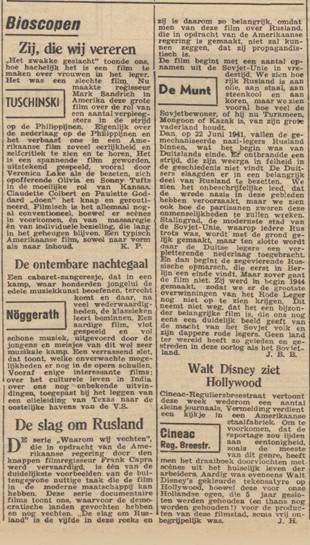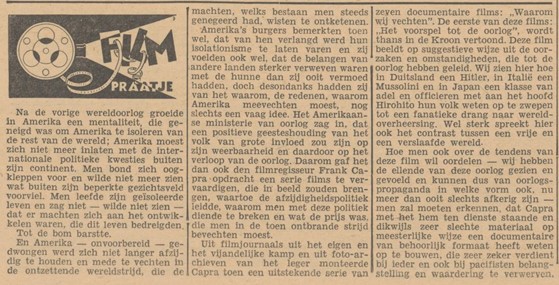Americanization
Why We Fight
Most people will know about the American involvement on the European continent during the Second World War. After the Japanese had bombed American soil during their attack on Pearl Harbor, the United States became completely involved in the war, bringing their soldiers to Europe. However, soldiers were not the only thing the Americans brought across the Atlantic. In addition to manpower, they brought propaganda tools; the movies, posters and magazines the Americans brought with them allowed the United States to shape European narratives at a crucial time.
Ulterior Motives?

Review of “De slag om Rusland” in De Waarheid Image © “De slag om Rusland.” De Waarheid (8 July 1945). Delpher: http://resolver.kb.nl/resolve?urn=ddd:010851094:mpeg21:p003
By providing materials for the Europeans to engage with, the Americans were able to create a narrative that was favorable for them and their plans for a post-war world. Examples of this type of Americanization can be found in Dutch newspapers: near and shortly after the end of the war, multiple Dutch newspaper printed reviews of Why We Fight, an American documentary series that was shot to explain the purpose of the war to the American people. Coincidentally, it could also be used to sell the war – and the United States – to European audiences (Roholl).
The first example of such a review is the one that communist newspaper De Waarheid wrote about the Battle of Russia, the fifth entry of the Why We Fight series. In their review, the newspaper praises the documentary. They appreciate the fact that it was about Russia, as it allowed audiences to learn about a different country and their experiences with the war. They appreciate even more that it was an American production, as this meant that it could not be propaganda (“De slag”). The newspaper believed that the United States, as one of their allies, would not spread propaganda in the Netherlands. Russia, apparently, would be much more likely to engage in such practices. De Waarheid furthermore deemed the Battle of Russia interesting and suitable for the Dutch audience to watch, as it is a good example of movies that have a useful task in today’s society (“De slag”). This review showcases the faith that people in the Netherlands had in the United States, even if it meant that they turned a blind eye to possible ulterior motives.
Propaganda
A lot of Dutch reviews about the Why We Fight series praise the documentaries in one way or another, which shows the admiration the Dutch had for the United States. The second review, pictured below, is an example. It is from social-democratic newspaper Het Parool. It discusses the first part of the series, called Prelude to War, and also the series as a whole. This second review does note that Prelude to War paints the events and circumstances that have led to the war in a ‘suggestive manner’, meaning that the paper is aware of at least a certain degree of propaganda. However, they also praise the work of director Frank Capra and the methods he used to turn the documentaries into a success. Het Parool is thus somewhat critical of the subjectiveness of the work, but still praises the professionalism of the American series.

“Filmpraatje” in Het Parool. Image © “FILM PRAATJE.” Het Parool (28 July 1945). Delpher: http://resolver.kb.nl/resolve?urn=MMNIOD05:000143114:mpeg21:p002
These two reviews are examples of how Dutch people perceived the American documentary series brought after the Americans came to Europe to fight in the Second World War. The American propaganda Dutch audiences were exposed to were influential in shaping Dutch perceptions of not only the United States but the war as a whole. It showed them images about their own country in Divide and Conquer, but there was also content about other countries, like in the Battle of Russia, the Battle of Britain, and the Battle of China. Additionally, War Comes to America dealt with the years leading up to the war from an American point of view. Although not all documentaries received the same attention in the Netherlands, it can be argued that the Why We Fight series are a clear example of American influence in the Netherlands though propaganda.
Sources
Roholl, Marja. “An Invasion of a Different Kind: The U.S. Office of War Information and “The Projection of America” Propaganda in the Netherlands, 1944 – 1945.” Politics and Cultures of Liberation, edited by Frank Mehring, Hans Bak, and Mathilde Roza. Brill, 2018, 17-38.